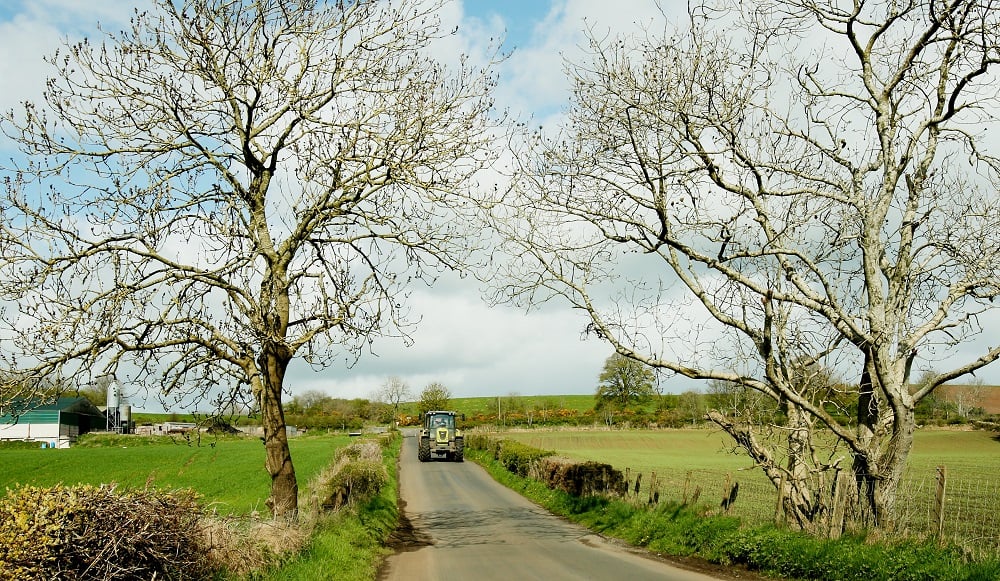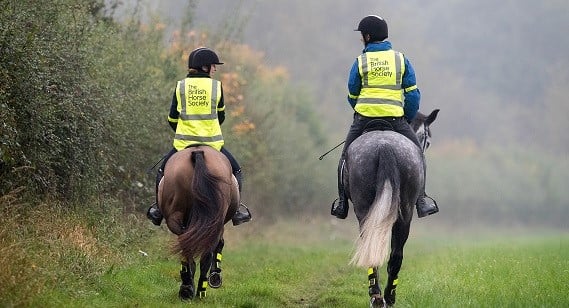Rural Road Safety Advice for Tractors

Tractors and other agricultural machinery are a common sight on rural roads, as farmers move between farms and other land that they own, and haul produce livestock and other materials around. Over recent years, tractors have increased in power, size and speed and so it’s more important than ever that drivers take all reasonable steps to ensure that they are operating machinery in a safe manner, with due consideration for other rural road users.
Along with some safer driving advice, we’ve shared our thoughts below on the steps that you can take to ensure that your tractor, trailers and other machinery are being operated correctly on the road:
1. Perform a vehicle Health Check
Prior to venturing onto the road, check that all lights, indicators and rotating beacons are working (including those on any trailers or lighting boards attached to the rear of trailed or mounted implements). Are the number plates clearly visible and mirrors clean and adjusted to provide the best view possible?
The NFU Farm Vehicle Health Check document provides comprehensive guidance around vehicle maintenance, including a useful checklist.
2. Be aware of other road users
Remember that those that can cause the greatest harm, have the greatest responsibility to reduce the risk they may pose to others on the road. Large tractors, trailers and implements have potential to cause great harm to other road users, so make sure that you follow the advice in this article.
When you become aware of traffic building up behind you, pull over when safe and legal to do so, to allow faster vehicles to safely pass you.
3. Keep a charged mobile phone with you
Make sure that you have a fully charged mobile phone available to be used when your vehicle is parked, to call for the emergency services if you are involved in any accidents or incidents, or come across these when on rural roads. Consider downloading the WhatThreeWords app on your phone, so that in the event of an incident, emergency services can easily find your location.
4. Use the appropriate seat and seatbelt
Only allow passengers to travel in your tractor or agricultural machinery where the manufacturer has provided a seat specifically designed for this purpose and always use seat belts (where fitted).
5. Maintain braking systems
Braking systems on both tractors and trailers / trailed machinery need to be maintained in line with the manufacturers recommendation. Consider using a service such as Tilly your Trailer Tilly Pass. Head to Tow. which provides an annual visual inspection service to ensure that trailer brakes, lights, tyres and towing eyes are serviceable. Their app also includes a handy checklist of daily, weekly and monthly trailer checks, based on the specific requirements of leading trailer manufacturers. Consider using a rolling road brake test to evaluate the efficiency of the brakes.
6. Demonstrate caution when turning with implements
Be aware that mounted and trailed implements will swing out when turning and could cause injury or damage to other road users or their property. Trailers with different axle configurations will swing out in different ways when making tight turns and allowances need to be made for this.
7. Take great care when pulling out of fields or gateways onto roads
Hedges and trees can compromise visibility and front mounted machinery only makes things more difficult. Where you cannot clearly see both directions down a road from the cab of the tractor, use somebody outside the vehicle to check for traffic and guide you safely onto the road.
8. Indicate well in advance and double check mirrors
When pulling into fields or farm entrances, use your indicators in good time, so that other road users are aware of your intentions. Look in your mirrors before manoeuvring, so that you can check for any vehicles that may be attempting to overtake whilst you are turning in. Take particular care when turning right, in case other vehicles are attempting to overtake you at that point.
9. Install front and rear facing dashcams
You might want to consider installing dashcams in your tractors as these can help to promote the right behaviours in your drivers. They are also useful if an incident does occur in terms of establishing liability.
10. Plan routes and timings of journeys
Plan your route to avoid busier periods, such as the start and end of the school day if you need to travel past rural schools or through village centres. When travelling in unfamiliar locations, plan your route in advance and make sure that you’re aware of any weight, height or width restrictions that could apply.
This article is supported by:
 |
 |
 |
 |
 |


